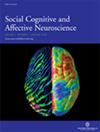西班牙语中的疼痛更痛?西班牙语-英语双语成年人的疼痛神经生物学
IF 3.1
2区 医学
Q2 NEUROSCIENCES
引用次数: 0
摘要
我们之前发现,西班牙-英语双语成人在接触到以其较强文化取向的语言表达的疼痛热时,会报告出较高的疼痛强度。在这里,我们阐明了参与语言驱动的疼痛反应改变的大脑系统。在分别进行的英语和西班牙语fMRI扫描过程中,39名(21名女性)双语成年人对夹杂在具有文化唤起力的图像和完成的句子阅读任务之间的热痛进行了评分。对文化认同和语言使用的调查测量了对美国文化和西班牙文化的相对偏好(文化取向)。与英语相比,参与者用西班牙语做出的强度评级更高。在躯体感觉皮层、扣带回皮层、楔前皮层和小脑皮层中,不同语言的疼痛诱发活动存在群体水平的全脑差异。与语义、注意力和躯体感觉处理相关的兴趣区在参与者的文化偏好语言中显示出更高的平均疼痛诱发反应,多元疼痛预测模式的表达也是如此。后续的调节中介分析表明,躯体感觉活动中介了语言对疼痛强度的影响,尤其是对西班牙裔参与者而言。这些发现与关于语言对感知和认知影响的性质的不同假设("中介"、"聚焦 "和 "诱导")有关。了解语言对疼痛的影响可以提高西语裔成年人的文化敏感性治疗方法的疗效,从而减轻该人群中存在的健康差异。本文章由计算机程序翻译,如有差异,请以英文原文为准。
Does pain hurt more in Spanish? The Neurobiology of Pain among Spanish-English Bilingual Adults
We previously found Spanish-English bilingual adults reported higher pain intensity when exposed to painful heat in the language of their stronger cultural orientation. Here, we elucidate brain systems involved in language-driven alterations in pain responses. During separate English- and Spanish-speaking fMRI scanning runs, 39 (21 female) bilingual adults rated painful heat intermixed between culturally evocative images and completed sentence reading tasks. Surveys of cultural identity and language use measured relative preference for US-American vs Hispanic culture (cultural orientation). Participants produced higher intensity ratings in Spanish compared to English. Group-level whole-brain differences in pain-evoked activity between languages emerged in somatosensory, cingulate, precuneus, and cerebellar cortex. Regions of interest associated with semantic, attention, and somatosensory processing showed higher average pain-evoked responses in participants’ culturally preferred language, as did expression of a multivariate pain-predictive pattern. Follow-up moderated mediation analyses showed somatosensory activity mediated language effects on pain intensity, particularly for Hispanic oriented participants. These findings relate to distinct (“meddler”, “spotlight”, and “inducer”) hypotheses about the nature of language effects on perception and cognition. Knowledge of language influences on pain could improve efficacy of culturally sensitive treatment approaches across the diversity of Hispanic adults to mitigate documented health disparities in this population.
求助全文
通过发布文献求助,成功后即可免费获取论文全文。
去求助
来源期刊
CiteScore
6.80
自引率
4.80%
发文量
62
审稿时长
4-8 weeks
期刊介绍:
SCAN will consider research that uses neuroimaging (fMRI, MRI, PET, EEG, MEG), neuropsychological patient studies, animal lesion studies, single-cell recording, pharmacological perturbation, and transcranial magnetic stimulation. SCAN will also consider submissions that examine the mediational role of neural processes in linking social phenomena to physiological, neuroendocrine, immunological, developmental, and genetic processes. Additionally, SCAN will publish papers that address issues of mental and physical health as they relate to social and affective processes (e.g., autism, anxiety disorders, depression, stress, effects of child rearing) as long as cognitive neuroscience methods are used.

 求助内容:
求助内容: 应助结果提醒方式:
应助结果提醒方式:


